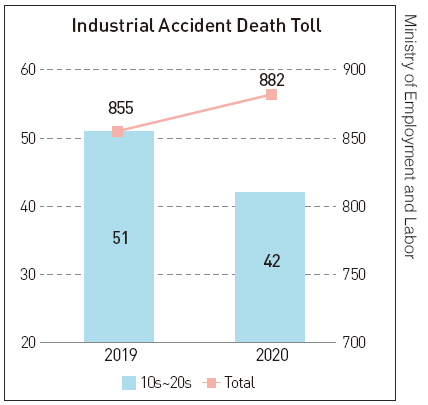On April 22, a college student worker in his 20s was crushed to death by a container during a cargo operation at Pyeongtaek Port. When he was crushed by a 300-kilogram container wing, there was no safety manager at the site. Dongbang, a responsible company, apologized to the public on May 12, after remaining silent for 20 days.
Surprisingly, these industrial accidents have occurred repeatedly and continued unabated. In 2019, a young worker died while installing an automatic subway door in Hwaseong, and in 2018, another young worker died by getting stuck in the conveyor belt in Tae-an. Under what circumstances are young people working in South Korea? The UOS Times would like to investigate this further.
According to the Ministry of Employment and Labor, the annual death toll from industrial accidents amounts to approximately 1,000. The actual death toll was 855 in 2019 and 882 in 2020. According to the current state of industrial accidents by age occurred between 2016 and 2020 obtained through the Justice Party lawmaker Kang Eun-mi’s office, 51 people in their 10s and 20s died from industrial accidents in 2019 and 42 in 2020. Young workers, in particular, are suddenly brought to the scene, not to their own business.
These industrial accidents have repeated over
and over again and not abated at all.
They are not familiar with the work they do and are unaware of the dangers involved. The fact that 96 percent of young industrial accidents are calamity accidents means that effective safety education and preventive measures are not being taken against young workers, who are at the bottom of the working class.
The seriousness of industrial accident deaths has been addressed before. In the 2018 New Year’s address, President Moon expressed his willingness to take action to reduce the number of deaths in three major sectors, including industrial safety, by half by 2022. At the end of that year, an amendment to the Industrial Safety and Health Act (Kim Yong-kyun Act), which significantly strengthened safety regulations at industrial sites, including the prevention of outsourcing of risks, was passed, which came into effect early last year. Even with the implementation of the amendment, named after Kim Yong-kyun, a worker who died of industrial accidents in Tae-an, the number of industrial accidents has increased slightly, rather than decreasing.
Why do these accidents continue happening without any decrease?
1. The risk of outsourcing industrial sites is a major reason. According to statistics, the number of subcontractors who died was much higher than that of the chief contractor. In the construction and manufacturing industries, where industrial accidents occur the most, multistage subcontracting is becoming common. In the process of reducing labor costs, these industrial sites have failed to comply with the safety rules, and subcontracting workers are at the dead-end of industrial safety.
2. Poor site environment and management supervision: Outsourcing to reduce labor costs neglects site safety. There are no safety managers or signal managers required under the Industrial Safety and Health Law. Moreover, there are many places that do not provide proper safety education and safety equipment. In addition, eight days before the container accident, the container was judged to be normal. This raises the doubt that the inspection was also defective.
3. Compensation for victims and punishment for companies are not properly given. As the compensation system for deaths caused by industrial accidents is insufficient, companies naturally believe that they will compensate for accidents rather than continuously bearing the costs of safety education. The law on the punishment of companies where serious disasters occur has been enacted recently, but it provides many exceptions. Resultantly, the laws are not stricter than before in practice. From unclear safety management entities covered by joint responsibilities of the chief contractor and subcontractors to three-year suspension for businesses with fewer than 50 employees where 50 percent of the total industrial accidents occur, businesses with fewer than five employees where one-third of the total industrial accidents occur are exempt from the disaster punishment act. This situation is what the government and politicians need to improve.
These reasons are organically connected and, therefore, the ground situation does not change easily.

Industrial accidents are not other people’s business,
but the business around us.
Social change has always been gradual. However, it seems that an accident has to happen to fix an issue and introduce necessary changes. Recent legal changes were made possible mainly because the victims’ families shed tears of blood and made efforts to prevent such accidents from happening again. The best thing is to identify and prevent an accident before it occurs. In the long run, the key is to encourage business owners to regard safety-related budget injections as investments, not expenses. Industrial accidents are not just other people’s business. You too might experience them someday. The reality of industrial accidents among young people is as heavy as 300-kilogram of iron.
Park Ji-yeong
vipp0925@uos.ac.kr
Lee Seo-yeon
sy001109@uos.ac.kr

